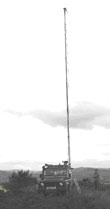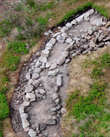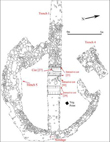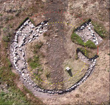
Shaw Cairn
The History of Shaw Cairn

 In 1975, John Bu'Lock identified what he thought was possible cairn on Mellor Moor above Cobden Edge, which is the highest point in Stockport, the trig point on Mellor Moor being at 328 meters (1076 feet). This area was once a plantation, but is now a wildlife preserve above the pastures of a working dairy farm. For the next several years, Ruth Collier, Kath Lowe and John Clarke excavated the site with help from students of Marple Hall School.
In 1975, John Bu'Lock identified what he thought was possible cairn on Mellor Moor above Cobden Edge, which is the highest point in Stockport, the trig point on Mellor Moor being at 328 meters (1076 feet). This area was once a plantation, but is now a wildlife preserve above the pastures of a working dairy farm. For the next several years, Ruth Collier, Kath Lowe and John Clarke excavated the site with help from students of Marple Hall School.
They uncovered parts of a funerary cairn built around 4000 years ago, with more than a dozen cremation burials, some within stone cists, which were given names like Willie, Pericles, Cecil and Hector. Those associated with burials were consistent with the building of the cairn in the Late Neolithic or Early Bronze Age but the finds included around 500 flints, many dating from the Early Mesolithic Period indicating that the Cairn was built on the site of much earlier activity. Unfortunately recording of the excavation was not to modern archaeological standards and the finds were never sent for analysis by experts in the appropriate fields. Afine example of a plano convex knife was amongst the finds along with an almost complete ceramic food vessel which has now been conserved and reconstructed.
Later Investigation - 2000
 The archive came to the Greater Manchester Archaeology Unit where a Bradford University student on placement, Victoria Mellor, produced a report. As part of the Mellor Heritage Project, the Trust set itself the task of recording the nature of the cairn more thoroughly and establishing the extent of the earlier excavations, examining the cairn's immediate unexcavated and attempting to understand the setting and nature of the prehistoric activity.
The archive came to the Greater Manchester Archaeology Unit where a Bradford University student on placement, Victoria Mellor, produced a report. As part of the Mellor Heritage Project, the Trust set itself the task of recording the nature of the cairn more thoroughly and establishing the extent of the earlier excavations, examining the cairn's immediate unexcavated and attempting to understand the setting and nature of the prehistoric activity.Read the Report on the Shaw Cairn investigations 1976-1988
2007

It was decided to send up a team to clear the heather in the spring and assess the area. Timing any investigation is difficult on the moor as it must be carried out when the weather is not too harsh on the exposed hilltop, the birds are not nesting or the undergrowth of heather at its height. It soon became clear however that the old excavations had not been back-filled and the team were able to clear the ground sufficiently to carry out further Geophysical Investigation.
2008 and 2009

 An evaluation excavation was then carried out in June 2008 which proved tremendously exciting. It confirmed the presence of a flat Ring Barrow covered in stone, with a kerb of large stones, surrounding piles of smaller stones and a stone lined grave known as a cist. Unfortunately most of the cist was found to have been damaged by previous digging so only a fraction remained of the original deposit with no trace of the burial itself.
An evaluation excavation was then carried out in June 2008 which proved tremendously exciting. It confirmed the presence of a flat Ring Barrow covered in stone, with a kerb of large stones, surrounding piles of smaller stones and a stone lined grave known as a cist. Unfortunately most of the cist was found to have been damaged by previous digging so only a fraction remained of the original deposit with no trace of the burial itself.


However, a tremendous amount of new information could still be gained from the site along with some remarkable finds.
 Spectacular photographs were taken from an arial camera give a wonderful birds eye view of the Cairn from above.
Spectacular photographs were taken from an arial camera give a wonderful birds eye view of the Cairn from above.
 Spectacular photographs were taken from an arial camera give a wonderful birds eye view of the Cairn from above.
Spectacular photographs were taken from an arial camera give a wonderful birds eye view of the Cairn from above.

 The Cairn was found to consist of both an inner and outer kerb with radials, which possibly suggest phasing. The size of the cist indicates that the burial was an inhumation and and within this disturbed fill was found a further fine plano-convex knife along with the more remarkable discovery of a number of rare and beautiful amber beads from a necklace. In the base of the cleaned out cist caneven be seen the marks of staining from the body.
The Cairn was found to consist of both an inner and outer kerb with radials, which possibly suggest phasing. The size of the cist indicates that the burial was an inhumation and and within this disturbed fill was found a further fine plano-convex knife along with the more remarkable discovery of a number of rare and beautiful amber beads from a necklace. In the base of the cleaned out cist caneven be seen the marks of staining from the body.
 |
 |
 |
 |
 |
 |
The 3D Animation of the cist below has been kindly produced for us by David Wilcox of Virneth Studios Click on the arrow buttons to play the animation and run through he sequence of burial
( Please enable "Allow Blocked Content" )
What is remarkable about the Amber Beads

Amber spacer necklaces are thought to represent one of the ultimate status symbols of the Early Bronze Age partly due to their extreme rarity. Individual amber beads have been found on burial sites from around the country but the finding of a substantially complete one at Mellor is extraordinary. Prior to this, amber necklaces have only been discovered in Britain within the internationally significant Bronze Age landscapes of Wessex and Orkney and associated with the very highest social status. Furthermore, it was believed that all amber necklaces in Britain derived from the Wessex area and that their production and exchange was controlled to some extent by the elite of this area.
Why is this important for the Stockport Area
Until this discovery this area was not thought to have been very rich in Bronze Age culture, being rather more associated with its Industrial Heritage. It now seems possible that Bronze Age sites may have been destroyed during the Industrial Revolution in the area and that in fact that extremely high status communities and individuals lived here during the Early Bronze Age.

The Pottery from Shaw Cairn
Parts of 10 different vessels were found during the recent excavations including: 6 definite Food Vessels; 3 possible/probable urns; 3 rimsherds and some body sherds of one thin, tiny, plain accessory vessel. The cremation deposit Hector seems to have had parts of 5 pots present (2 Food Vessels, 2 possible ursn plus the accessory vessel) which suggests that there may have been more than one interment in that grave. There are several good examples of where pots have come apart along ring joint lines, and these show how the pots had been built up. It may be possible to carry out lipid analysis to see whether any of the funerary pottery had been used for cooking before burial. The fact that there are so many Food Vessels supports the view that the cairn may only have been used for a few generations, possibly between around 4,100 and 3,800 years ago. It may be possible to obtain Carbon 14 dates from the cremated remains and Osteology Reports from the fragments of bone to see whether individual deposits contain more than one individual, as is apparenlty often the case).
Parts of 10 different vessels were found during the recent excavations including: 6 definite Food Vessels; 3 possible/probable urns; 3 rimsherds and some body sherds of one thin, tiny, plain accessory vessel. The cremation deposit Hector seems to have had parts of 5 pots present (2 Food Vessels, 2 possible ursn plus the accessory vessel) which suggests that there may have been more than one interment in that grave. There are several good examples of where pots have come apart along ring joint lines, and these show how the pots had been built up. It may be possible to carry out lipid analysis to see whether any of the funerary pottery had been used for cooking before burial. The fact that there are so many Food Vessels supports the view that the cairn may only have been used for a few generations, possibly between around 4,100 and 3,800 years ago. It may be possible to obtain Carbon 14 dates from the cremated remains and Osteology Reports from the fragments of bone to see whether individual deposits contain more than one individual, as is apparenlty often the case).
An archaeoastronomical observation
One of our volunteers has contributed the observation that there appears to be a deliberate orientation towards the NNW that closely mirrors that at Arbor Low, suggesting that Shaw cairn was pointed towards the solsticial sunset ca 2500BC. It could indicate a level of astronomical sophisticationand shared knowledge with those from Arbor Low and possibley even Wessex and Stonehenge
Read the Geophysics Reports from Shaw Cairn
An article by Philip Day on the chemical analysis of the beads What is Amber Update on analysis of the remains at Shaw Cairn (September 2010) By Dr Alison Sheridan.
Nearby accommodation can be found on the environmentally friendly and responsibly managed Shaw Farm Static Caravan Site whose owners, George, Nicky and Graham Burgess, have been extremely supportive in the work of the Trust.
